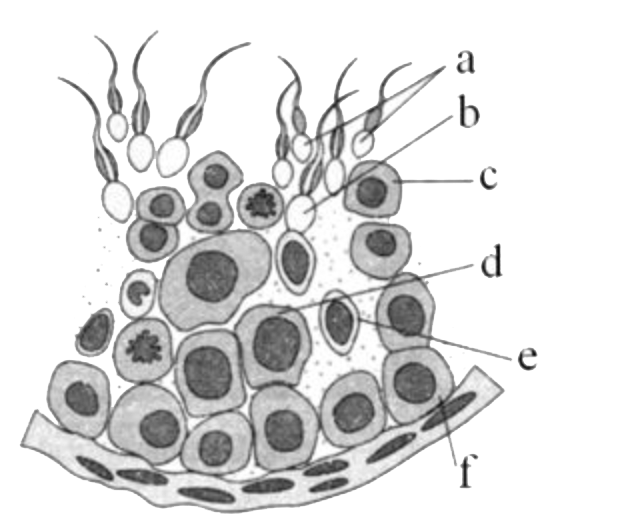Spermiogenesis is a process in which :-
(a) spermatids change into spermatozoa
(b) spermatogonia produce a spermatid
(c) spermatocytes give rise to spermatozoa
(d) dormant spermatozoa become active just before ejaculation
spermatids change into spermatozoa
spermatogonia produce a spermatid
spermatocytes give rise to spermatozoa
dormant spermatozoa become active just before ejaculation.
The correct Answer is:A
To solve the question regarding spermiogenesis, let's analyze each option step by step:
1. Understanding Spermiogenesis:
- Spermiogenesis is a specific phase in the process of spermatogenesis, which is the overall process of sperm formation. It involves the transformation of spermatids into mature spermatozoa.
2. Evaluating Each Option:
- (a) Spermatids change into spermatozoa: This option describes the actual process of spermiogenesis. During spermiogenesis, spermatids undergo morphological changes to become spermatozoa (mature sperm).
- (b) Spermatogonia produce a spermatid: This option describes an earlier stage in the process of spermatogenesis, not spermiogenesis. Spermatogonia are the initial germ cells that undergo mitosis and meiosis to eventually form spermatids.
- (c) Spermatocytes give rise to spermatozoa: This option is also incorrect in the context of spermiogenesis. Spermatocytes undergo meiosis to produce spermatids, which then undergo spermiogenesis to become spermatozoa.
- (d) Dormant spermatozoa become active just before ejaculation: This option does not describe spermiogenesis. It refers to the activation of spermatozoa, which is a different process.
3. Conclusion:
- Based on the definitions and processes described, the correct answer is (a) spermatids change into spermatozoa. This accurately reflects the process of spermiogenesis.
Final Answer:
(a) spermatids change into spermatozoa
- Spermiogenesis is a specific phase in the process of spermatogenesis, which is the overall process of sperm formation. It involves the transformation of spermatids into mature spermatozoa.
- (a) Spermatids change into spermatozoa: This option describes the actual process of spermiogenesis. During spermiogenesis, spermatids undergo morphological changes to become spermatozoa (mature sperm).
- (b) Spermatogonia produce a spermatid: This option describes an earlier stage in the process of spermatogenesis, not spermiogenesis. Spermatogonia are the initial germ cells that undergo mitosis and meiosis to eventually form spermatids.
- (c) Spermatocytes give rise to spermatozoa: This option is also incorrect in the context of spermiogenesis. Spermatocytes undergo meiosis to produce spermatids, which then undergo spermiogenesis to become spermatozoa.
- (d) Dormant spermatozoa become active just before ejaculation: This option does not describe spermiogenesis. It refers to the activation of spermatozoa, which is a different process.
- Based on the definitions and processes described, the correct answer is (a) spermatids change into spermatozoa. This accurately reflects the process of spermiogenesis.
(a) spermatids change into spermatozoa
Topper's Solved these Questions
- REPRODUCTIVE SYSTEM , EMBRYOLOGY AND REPRODUCTIVE HEALTH BOOK - ALLENCHAPTER - REPRODUCTIVE SYSTEM , EMBRYOLOGY AND REPRODUCTIVE HEALTH EXERCISE - Ovarin Follicles and Menstrual Cycle
9 Videos
- REPRODUCTIVE SYSTEM , EMBRYOLOGY AND REPRODUCTIVE HEALTH BOOK - ALLENCHAPTER - REPRODUCTIVE SYSTEM , EMBRYOLOGY AND REPRODUCTIVE HEALTH EXERCISE - Types of egg and fertilization
3 Videos
- REPRODUCTIVE SYSTEM , EMBRYOLOGY AND REPRODUCTIVE HEALTH BOOK - ALLENCHAPTER - REPRODUCTIVE SYSTEM , EMBRYOLOGY AND REPRODUCTIVE HEALTH EXERCISE - Female Reproductive System
4 Videos
- REPRODUCTIVE HEALTHBOOK - ALLENCHAPTER - REPRODUCTIVE HEALTHEXERCISE - S
19 Videos
- RESPIRATION IN PLANTSBOOK - ALLENCHAPTER - RESPIRATION IN PLANTSEXERCISE - Diagram Based question
5 Videos
Similar Questions
Correct sequence of spermatogenesis :
(a) spermatogonia
(b) spermatids
(c) primary spermatocyte
(d) secondary spermatocyte
(e) spermatozoa
View SolutionSpermatids are transformed into spermatozoa by the process of
View SolutionSpermatids are transformed into spermatozoa by the process called.
View SolutionHow many structures are haploid ?
Spermatogonia , spermatozoa, spermatids, primary spermatocyte, secondary spermatocyte
View SolutionRecognize the figure and find out the CORRECT labeling.

(a) a -spermatozoa, b - spermatid, c - primary spermatocyte , d - secondary spermatocyte , e - spermatogonia , f - sertoli cell
(b) a -spermatozoa, b - spermatid, c - secondary spermatocyte , d - primary spermatocyte - Sertoli cell , f - spermatogonia
(c) a -spermatozoa, b - spermatid, c - primary spermatocyte , d - secondary spermatocyte , e - spermatogonia , f - sertoli cell
(d) a -spermatozoa, b - spermatid, c - secondary spermatocyte , d - primary spermatocyte - Sertoli cell , f - spermatogonia
View SolutionWhich of the following undergoes spermiogenesis :
(a) Spermatids
(b) Spermatogonia
(c) Primary spermatocytes
(d) Secondary spermatocytes
View SolutionArrange in correct sequence the structures formed during spermatogenesis
a) spermatogonia
b) Secondary spermatocyte
c) Spermatogonial stem cells
c) spermatogonial stem cell
d) primary spermatocyte
e) spermatid
View SolutionDuring spermatogenesis how many spermatozoa are formed from a single primary spermatocyte?
(a) 1
(b) 2
(c) 4
(d) 8
View SolutionWhich pair of cells appear during the process of spermatogenesis?
(a) Spermatogonia, sperm lysin
(b) Oocyte, Spermatozoa
(c) Spematid, Primordial follicle
(d) Spermatogonia, Spermatozoa
View SolutionWhich of the following is incorrect about spermatogenesis?
(a) Meiosis-l leads to the formation of secondary spermatocytes
(b) Meiosis-II leads to the formation of spermatids
(c) Production of one sperm and 3 polar bodies
(d) Primary spermatocytes are diploid in nature
View Solution